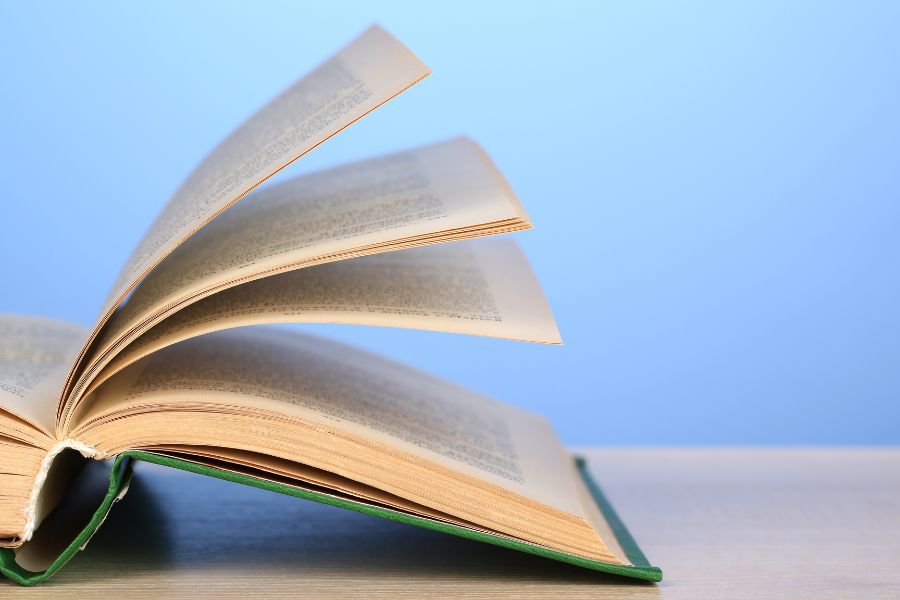Struggling to write a story that grips your readers from start to finish? The secret might just be mastering the right story structure.
Whether you’re crafting a short story or an epic saga, understanding the bones of a well-told tale can make or break your narrative.
From the classic Hero’s Journey to the intricate Seven-Point Structure, we’ll unpack each indispensable narrative structure and give you actionable insights to apply to your next masterpiece.
Curious?
Let’s dive right in.

What Is Story Structure?
Story structure is the underlying framework that shapes a narrative.
It’s the blueprint that determines how your book unfolds, which events are highlighted, and when emotional peaks and troughs occur.
A well-defined structure ensures that a narrative flows smoothly, keeping readers engaged and invested from the opening line to the closing sentiment.
And just as a solid blueprint is crucial for an architect creating a building, the right story structure is indispensable for crafting memorable tales.
Understanding and harnessing the power of story structure is like having a map for an epic adventure.
So, what story structures should you familiarize yourself with?
10 Story Structures Every Writer Should Know

Storytelling offers a range of structures, each shaping narratives in distinct ways. Here, we’ll introduce several foundational blueprints that can elevate your tales…
1. The Classic Story Structure
Almost every story includes the following specific milestones. Think of these as signposts guiding your reader on a journey:
- Opening/Exposition: This is your story’s entry point. It sets the scene, introduces each main character, and provides context.
- Inciting Incident: Often occurring early in the narrative, this event disrupts the protagonist’s world and sets the story in motion.
- Rising Action/Crises: A series of events that intensify the story’s central conflict.
- Climax: The narrative’s high point, where tensions reach their peak.
- Falling Action/The Denouement: Here, the story starts winding down. It deals with the aftermath of the climax and sets the stage for the resolution.
- Resolution: The narrative’s conclusion. Loose ends are tied up, and the story comes full circle.
In the movie Jaws, the Amity Island community faces shark attacks (Exposition), a boy gets devoured (Inciting Incident), the town struggles with keeping beaches safe (Rising Action/Crises), Chief Brody confronts the shark at sea (Climax), the aftermath of the battle sees the destruction of the shark (Falling Action), and Brody and Hooper paddle back to shore, forging a bond (Resolution).
2. The Hero’s Journey
Devised by Joseph Campbell, The Heros Journey is a 12-step archetypal story structure that charts the protagonist’s voyage from the ordinary world to an unfamiliar realm and back again:
- Ordinary World: Our hero’s status quo, the world they’re familiar with.
- Call to Adventure: An event or message that disrupts the hero’s life.
- Refusal of the Call: Initial hesitations or fears about embarking on the journey.
- Meeting the Mentor: The hero encounters someone who provides advice, training, or a crucial item.
- Crossing the Threshold: The hero leaves the known world for the unknown.
- Tests, Allies, Enemies: In the unfamiliar realm, the hero faces challenges, makes friends, and encounters foes.
- Approach to the Inmost Cave: Preparations are made to confront the central challenge or antagonist.
- Ordeal: A high-stakes challenge where the hero faces death or their biggest fear.
- Reward: After the ordeal, the hero achieves a tangible or intangible reward.
- The Road Back: With the reward in hand, the hero starts for home.
- Resurrection: A final test where the hero must use everything they’ve learned.
- Return with the Elixir: The hero returns to the ordinary world, transformed, bearing some wisdom or solution to benefit their original environment.
Star Wars is the quintessential example of the Hero’s Journey. Protagonist Luke Skywalker starts in the ordinary world, receives a call to adventure with Princess Leia’s message, faces tests and challenges, and ultimately returns transformed after confronting the Dark Side.
3. The Three-Act Structure
The three-act structure divides your story into three distinct sections: the setup, the confrontation, and the resolution. This method offers a clear and concise roadmap for authors to ensure their story keeps readers engaged.
- Act I (Setup): This act introduces readers to the story’s world, characters, and the primary conflict. It sets the stage, grounding your readers with the necessary details before moving forward.
- Act II (Confrontation): The story’s meat. Here, characters face a series of challenges and obstacles, each one escalating in intensity. It’s all about building tension, leading up to the climax.
- Act III (Resolution): The climax has unfolded, and this act deals with its aftermath. It resolves any lingering questions and offers a satisfying conclusion.
In The Matrix, Act I introduces us to Neo’s ordinary world and the mysterious Matrix, culminating in him taking the red pill. Act II covers Neo’s training, his initial confrontations with the agents, and the rescue of Morpheus. Then Act III is when Neo fully realizes his role as “The One,” and defeats the agents.
4. The Snowflake Method

Conceived by Randy Ingermanson, the Snowflake Method is a method for writers to create stories. It’s all about starting small and expanding outwards, much like how a snowflake forms. Writers begin with a central idea and gradually flesh it out into a full-fledged story, layer by layer.
- One-Sentence Summary: Start with a concise statement encapsulating your story’s core.
- Expand to a Paragraph: Take that sentence and expand it into a summary paragraph, detailing major events and the climax.
- Character Profiles: Delve into each main character. Chart their goals, motivations, conflicts, and arcs.
- Expand Each Sentence: Take your summary paragraph and grow each sentence into its paragraph, giving more detail about the story’s progression.
- Detailed Character Charts: Deep dive into all characters, understanding their backgrounds, relationships, and roles in the plot structure.
- Expand Each Paragraph: Now, take each paragraph from step 4 and grow it further, breaking down scenes and specifics.
- Character Scenes: Create a scene list for every character, tracking their individual journeys.
- Expand Scenes: Delve deeper into each scene, detailing what happens step by step.
- Write the Story: With all your details in place, start your first draft.
- Refine: Edit, adjust, and perfect your narrative.
5. The Seven-Point Structure
The Seven-Point Structure, popularized by Dan Wells, focuses on seven pivotal moments in your story:
- Hook: Capture your audience’s attention by introducing the characters and setting in a state of relative normalcy before the events of the story change everything.
- First Plot Point: This is the event that sets the story in motion and pushes the protagonist out of their comfort zone.
- First Pinch Point: A reminder of the story’s central threat, often raising stakes.
- Midpoint: A significant event that changes the protagonist’s objective, often involving a revelation or twist.
- Second Pinch Point: This is another reminder of the story’s antagonistic force, escalating the conflict.
- Second Plot Point: This is the final injection of new information before the story races to its climax.
- Resolution: The climax’s fallout and how the events of the story changed or affected the characters.
For example, in The Hobbit, readers are hooked when they meet Bilbo, then the first plot point ensues when Bilbo joins the dwarves. The first pinch point is when the company meet the trolls, and the midpoint is when Bilbo discovers the One Ring. The second pinch is when the company encounters the Mirkwood spiders, the second plot point is when Bilbo faces Smaug, and the resolution is the Battle of the Five Armies.
6. The Story Circle
Originated by Dan Harmon, the Story Circle represents a journey that loops back to where it started, reflecting the cyclical nature of many narratives:
- You: Establish the protagonist in their normal environment.
- Need: Identify something lacking in their life, pushing them towards an objective.
- Go: The protagonist steps into an unfamiliar situation.
- Search: They adapt to this new environment, overcoming various obstacles.
- Find: The protagonist gets what they were after but often at a cost.
- Take: They pay the price for their achievement.
- Return: With their prize in tow, they return to their familiar situation.
- Change: Demonstrates how the journey has transformed the protagonist.
Consider the story of The Lion King. Simba starts in the Pride Lands (You), is forced to escape after Mufasa’s death (Need), ventures into the jungle (Go), grows up with Timon and Pumbaa (Search), decides to confront Scar (Find), faces the challenges of reclaiming Pride Rock (Take), returns as king (Return), and the Pride Lands thrive under his rule, showcasing his growth (Change).
7. Freytag’s Pyramid
Freytag’s Pyramid is a time-tested tool for story structuring, emphasizing the traditional arc of drama. The pyramid is divided into five distinct stages:
- Exposition: Here, we’re introduced to characters, setting, and the initial situation.
- Rising Action: Events build, complications arise, and tension mounts.
- Climax: The story’s most intense point.
- Falling Action: Winding down the narrative tension.
- Dénouement/Resolution: The story’s final outcomes.
For example, in Shakespeare’s Romeo and Juliet, the exposition introduces the feuding Montague and Capulet families. The rising action showcases the lovers’ secret meetings and plans, leading to the climax of Romeo’s banishment. Then, the falling action includes Juliet’s faked death, and the dénouement concludes with the lovers’ real deaths.
8. The Fichtean Curve
Instead of one continuous rise to climax, The Fichtean Curve (created by John Gardner) presents several tension-building events followed by relief moments, creating a series of peaks and valleys:
- Rising Action: The curve thrusts its protagonist directly into the fray, immediately introducing an inciting event. As the story unfolds, the hero grapples with successive crises, increasing stakes, and pushing the narrative arc upwards.
- Climax: Approximately two-thirds through the narrative journey, this is the culmination of every preceding crisis.
- Falling Action: This segment addresses lingering questions, soothes raw nerves, and finalizes the protagonist’s transformative arc.
To envision the Fichtean Curve, think of The Wizard of Oz. Dorothy’s journey. The tornado’s whirlwind, her confrontations with witches, and her eventual homecoming show the story’s rhythmic rise and fall.
9. A Disturbance & Two Doorways

This structure by James Scott Bell involves three pivotal moments to guide your story:
- Disturbance: An early event that shakes up the protagonist’s world.
- First Doorway: A no-turning-back point where the protagonist is propelled into the main conflict.
- Second Doorway: Leading into the story’s climax, this moment propels the narrative toward its conclusion.
For example, in The Matrix, the disturbance is Neo’s initial encounter with the truth about the Matrix. The first doorway occurs when he chooses the red pill, plunging him into the rebellion against the machines. The second doorway is his decision to save Morpheus, setting the stage for the climactic showdown.
10. Pixar’s Story Spine
The Story Spine is an essential tool in improvisational storytelling. It lays out a straightforward progression:
- Once upon a time: Introduction of setting and characters.
- Every day: Establishing a routine or the status quo.
- But one day: The event that disrupts the routine.
- Because of that: Consequences of the disruption. Repeat this several times.
- Until finally: The climax or pivotal turning point.
- And ever since then: The resolution or the new status quo.
Now, let’s see how this structure works with Pixar’s movie Up: The story starts with Carl’s everyday routine with Ellie, but one day Ellie passes away. Because of that, Carl faces eviction. To honor Ellie’s dream, he decides to fly his house to Paradise Falls, leading to various adventures until finally, he realizes the importance of moving on. Ever since then, he finds a new purpose in life being a mentor to Russell.
How to Choose the Best Story Structure for Your Tale

How do you decide what story structure to use? Here are three guiding principles:
- Grasp your story’s essence: For example, one central heroic figure might suit The Hero’s Journey, while escalating crises fit the Fichtean Curve.
- Assess your characters: a single protagonist with multiple challenges might align with the Hero’s Journey, but interwoven destinies of multiple characters could demand a multi-timeline structure.
- Recognize your preference: Reflect on stories you’ve appreciated, discern their structure, and gauge what clicked. Don’t shy away from experimenting with various structures, seeking feedback for refinement.
Ultimately, choose a structure that complements your story’s heart, as that’s what truly engages readers.
Master the Story Structure & Captivate Your Audience
Navigating the vast landscape of story structures can be daunting, but you’ve now gained the tools and insights to harness their power.
With the knowledge from this article, you’re poised to craft tales that will resonate deeply with readers, drawing them into the worlds you’ve envisioned.
As you pen your next story, embrace the structure that feels right, and let it guide your narrative to its fullest potential.
Here’s to the stories only you can tell, and the audiences eagerly waiting for them!



